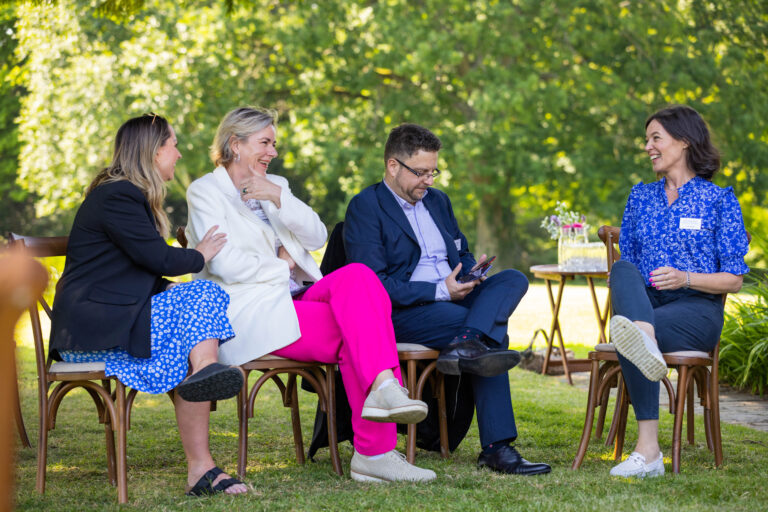
This post explores why 75% of change initiatives fail and what can be done about this.
Four ways forward are suggested: (1) frame the problem accurately; (2) navigate the unknown; (3) rethink your purpose; and (4) build social capital. Practical examples of how leaders have worked together to solve “wicked” or adaptive problems are included.
A widely accepted truth of organisational life is that change initiatives fail more often than they succeed.
The statistics speak for themselves: 75% of change programmes either stall or fail to achieve their objectives. According to Professor Keith Grint at Warwick Business School, the pervasive problem of the “change maze” confronts leaders everywhere – across different organisations, sectors and geographies. In a world where geopolitical, environmental and economic problems are ever increasing, what can we do about this?
A good starting point is to pay attention to how we frame a challenge.
Depending on our perspective, we can either galvanize collective action or cut it off at the pass. Using Rittell and Webber’s classic (1973) typology, it helps to differentiate between “tame” vs. “wicked” problems:
- Tame problems might be complicated but they are ultimately resolvable through applying existing knowhow, expert insight or standard operating procedures. Examples include timetabling the railways, building a nuclear plant or handling a wage negotiation.
- Wicked problems, on the other hand, are complex, intractable and require an innovative response to a novel situation. Developing a transport strategy, solving knife crime or developing an industrial relations strategy are all examples of wicked problems. They involve longer timeframes and a more strategic focus.
Wicked problems have what Grint calls no “stopping points”.
They do not end at the boundaries of a single organisation; they reside at the interface between different organisations or across the divisions of the same organisation. Consequently, wicked problems have no easy solutions. As leaders are typically more comfortable with tame or more technical problems, Grint comments:
“The irony of leadership is that it is often avoided where it might seem the most necessary.”
Having worked with groups of leaders from many different organisations for the last 10 years, here are 3 approaches that I’ve also found to be helpful when encountering the tough reality of a wicked problem.
1. Navigate the unknown
A valuable starting point is for leaders for accept that they don’t have the answer. While we are often not rewarded for saying “I haven’t got a clue”, this can be a creative act. It encourages us to leave behind the world of neat analytic models and rational plans and wander into a more experimental landscape.
Grint encourages leaders to be ad hoc, opportunistic and original. Instead of making out like an architect with a clean sheet of paper, he suggests that the approach of the Bricoleur do-it-yourself craftsperson is more productive. Leaders need to make do with what’s available and “stick together” what may appear to be a clumsy solution. Wicked problems do not call for elegant solutions; they call for a pragmatic approach.
One group of high performing leaders I worked with faced the challenge of moving from a global business model to a regional model. The risk to them, as a global team, was that this would put them all out of a job. The organisation, however, wanted their collective intelligence to come up with a new regional structure. To get the dialogue going, I suggested we use the following frame. Each person spoke to:
- “What I know is…”
- “What I don’t know is…”
- “What’s emerging is…”
After some time away from the office and some collective sense-making, a good-enough solution slowly started to emerge. The result was that six months later, the shift to the new regional structure had taken place and everyone in the global team had successfully found a new job. The team had faced into the uncertainty and found a way to navigate through it.
2. Rethink your purpose
Another team of leaders I worked with recently had a breakthrough in their thinking when they remembered the “big picture” mission of their organisation. It is all too easy, particularly when ambiguity runs high and complexity looms large, for thinking to narrow and action to contract.
In this financial services organisation, these senior leaders spent much of their time preparing reports, presenting to the executive committee and managing their staff. It was easy and understandable that they would, in the cut-and-thrust of rushing from meeting to meeting, lose sight of the real reason for the organisation’s existence – serving the customers on the high street.
Once we brought the customers’ perspective back into the room, the whole dialogue shifted to a different place. People became energised, thinking deepened and solutions started to emerge
3. Build social capital
Wicked problems demand a collective response and a collaborative process to solve them. This requires restructuring relationships. People who may not usually sit around the table need to get in the room together. There may be no obvious “leader’ as peers join forces to think together. The solution may only emerge when diverse perspectives are heard – and understood.
Working with wicked problems means letting go of rules and routines. It calls on us to shift from expert to investigator. We need to find ways of “muddling through” together rather than trying to pull levers in the right sequence.
One group of 70 leaders I worked with in an international development organisation spent two days thinking together about how to operationalize a contentious new strategy.
My co-facilitator and I encouraged them to raise their concerns and air their doubts about the possible risks that the new strategy involved. After spending time listening to each other, there was then enough spaciousness in the shared psychic space for some new thinking to emerge.
At the end of our time together, we had a single sheet of flip chart paper that captured the next steps. When dealing with a wicked problem, it helps not to have a complex set of actions but to focus on what’s needed next. The litmus test is whether there is a felt sense of rightness about the next step. A change initiative is then more likely to be in the 25% that succeed than in the slush pile of the 75% that fail.
For reflection
If you are facing a wicked problem where technical know-how, expert solutions and routine management are no longer enough, ask yourself:
- How can I “sit with” the uncertainty instead of rushing to find a solution? What do I know? What don’t I know? What is emerging?
- What is the larger purpose of the organisation or team of which I am part? Whose perspective might I be overlooking? What difference might it make to include this?
- Who could I talk and think with about a way forward? Who might hold a different piece of the puzzle here? What would energise them to talk with me?
Reference
Rittell, H and Webber M. (1973) Dilemmas in a general theory of planning, Policy Sciences, 4, 155-69.
To read more about Professor Keith Grint’s perspective on leadership, see:


